An insatiable appetite for ancient and modern tongues


Classification: Indo-European, Slavic, West Slavic, Lechitic. The Lechitic sub-group includes, besides Polish, a number of extinct languages spoken formerly in north Germany of which Polabian is the best known. Other West Slavic languages, not belonging to Lechitic, are Czech and Slovak.
Overview. Polish is the national language of Poland. Its recorded history starts in the 12th century though long texts appear only in the 14th century. Due to the early and perduring influence of the Western Church, Polish uses the Latin alphabet.
It has a rich consonantal system including, like all Slavic languages, palatalized consonants. Its nominal morphology has preserved to a great extent the complexity of old Indo-European languages, most notably in its declension system. In contrast, the verbs are far simpler having only two basic tenses and a couple of periphrastic ones.
Distribution. Polish is spoken by the vast majority of the present population of Poland. There are, also, many Polish speakers in Ukraine and Belarus (though comparatively few in Russia) as well as in Lithuania and Germany. Polish migrants are found mainly in North America and Israel.
Speakers. About 41 million worldwide, in the following countries:
Poland
Ukraine
U.S.A.
Belarus
Lithuania
Canada
Germany
Israel
38,000,000
1,150,000
670,000
400,000
260,000
250,000
240,000
100,000
Status. Polish is the official language of Poland and also one of the 23 official languages of the European Union.
Varieties. There are five major dialects corresponding to the same number of historical regions:
-
•Great Polish in the northwestern region of Wielkopolska.
-
•Cashubian, considered by many as a different language, in Kaszuby, to the north of Wielkopolska.
-
•Mazovian in the northeastern region of Mazowske.
-
•Little Polish in the southeastern region of Małopolska.
-
•Silesian in Śla̢sk, to the west of Małopolska.
Oldest Documents
-
1136.Papal Bull of Gniezno. More than 400 geographical and personal names are registered in this bull issued by Innocent II.
-
1155.Bull of Wrocław. A papal bull, issued in Breslau, containing 50 Polish names.
-
1270.A quotation in a history of a Cistercian monastery (written in Latin) is the first Polish sentence known.
-
1350.Holy Cross Sermons (Kazania Świętokrzyskie) is the first long Polish text.
-
1531.Printing of the first Polish book.
Phonology
Vowels (7). Formerly, Polish had short and long vowels but around the fifteenth century vocalic quantity ceased to be a relevant phonemic distinction. Modern Polish has just five oral vowels and two nasal ones (ɛ̃ and ɔ̃, written as ę and a̢), The distribution of the latter is restricted, occurring only at the end of a word or before fricatives.

Consonants (35). Polish has several palatalized consonants (marked with an accent in the table), though the alveolar obstruents are not (in contrast with Russian). One distinctive feature of the language is the occurrence of three series of voiceless and voiced sibilants and affricates. Voiced consonants are devoiced at the end of a word. Double consonants are common.

Stress: falls on the penultimate syllable in most words. Exceptions are words of Greek and Latin origin and some verbal forms (first and second plural persons in the past tense have antepenultimate stress).
Script and Orthography
Polish is written in a Latin-derived alphabet supplemented with diacritics. It consists of 32 letters:

the letters q, v and x are not part of the Polish alphabet but may appear in foreign words.
-
‣several digraphs (ch, cz, dz, dź, dż, rz, sz) are treated as sequences of separate letters (they are explained below).
-
‣[u] is represented (for historical reasons) by ó or u.
-
‣The letters i and y represent the same phoneme [i]. But the letter i has the additional function of reflecting the pronunciation of an immediately preceding consonant: either palatalization (of p, b, f, v, m, n) or postalveolar articulation before a vowel. Thus:
-
•a palatalized n is represented by ń at the end of a word or before a consonant and by ni before a vowel (if the vowel following is [i], it is not shown separately in the spelling).
-
•palatalization of other consonants (p, b, f, v, m) occurs only before a vowel and are, then, represented as pi, bi, fi, vi, mi to distinguish them from the non-palatalized ones (e.g. 'white' is written biały but pronounced b́awi).
-
•[tɕ] is represented by ć at the end of a word or before a consonant and by ci before a vowel Similarly, [dʑ] is represented by dź or dzi, [ɕ] by ś or si, and [ʑ] by ź or zi.
-
‣[ts] is represented by c, and [dz] by the digraph dz.
-
‣[tʃ] is represented by cz, and [dʒ] is represented dż.
-
‣[ʃ] is represented by sz, and [ʒ] by rz or ż.
-
‣[x] is represented by ch or h.
Morphology
-
Nominal. Nouns and adjectives are inflected for gender, number and seven cases.
-
•gender: masculine, feminine, neuter. Masculine nouns are divided into animate-inanimate in the singular. In the plural there is a distinction between masculine-person nouns and non-masculine person ones; the first category encompasses all male humans, the second everything else.
-
•number: singular, plural. A relic of the Old Polish dual subsists in paired parts of the body.
-
•case: nominative, vocative, accusative, genitive, instrumental, dative, locative.
-
There are four types of noun and adjective declension based mostly on gender:

-
‣a-stems: most of them are feminine, but if they refer to a male are masculine.
-
‣masculine o-stem
-
‣neuter o-stem
-
‣i-stem: includes feminine nouns.
-
Let's see the declensions of the following nouns: feminine głowa (‘head’), masculine ptak (‘bird’), neuter słowo (‘word’), and feminine noc (‘night’).
-
Masculine o-stem animate nouns and adjectives (referring to human beings and other animals) have an accusative singular form identical to the genitive singular (like ptak above). In inanimate nouns, the accusative singular of this stem coincides, instead, with the nominative singular.
-
In the plural, there are two different subgenders: one encompasses all male humans and the other everything else. In the first subgender the accusative plural has the same form as the genitive plural; in the second the accusative plural is the same as the nominative plural.
-
In the plural, genitive, dative, instrumental, and locative are the same in all stems, except for i-stems, where the genitive is different.
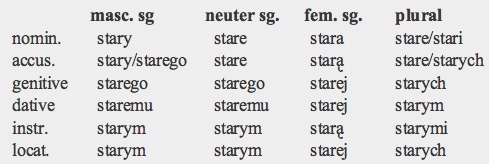
-
•adjectives: adjectival declension distinguishes gender in the singular but not in the plural. In other words, the plural declension is common to all genders. As an example, the declension of stary (‘old’) is shown in the table.
-
When referring to an inanimate noun, the accusative singular is identical to the nominative singular; in contrast if the noun is animate (humans, animals) the accusative singular is identical to the genitive singular. In the plural, non-masculine person adjectives (referring to women, animals, inanimates) have the same nominative and accusative forms (stare), but in masculine person adjectives the accusative is identical to the genitive. Masculine and neuter share the same genitive, dative, instrumental and locative.
-
•pronouns: personal, reflexive, possessive, demonstrative, interrogative, indefinite, negative, relative.
-
Personal pronouns distinguish three genders in the third person singular, and between male persons and non-male persons in the third person plural. Besides, there is a reflexive pronoun and a series of honorific second person pronouns: pan (masculine singular), pani (feminine singular), panowie (masculine plural), panie (feminine plural), państwo (mixed gender plural); they are used with third person forms of the verb.
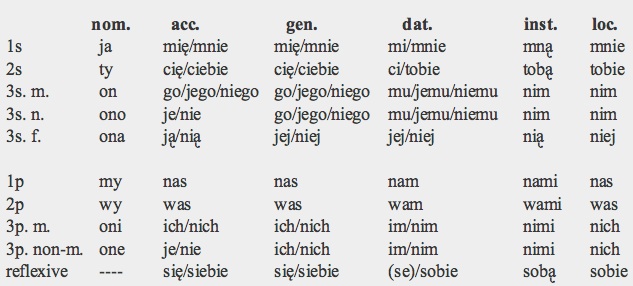
-
When more than one form is listed, the monosyllabic ones are enclitics (the most frequently used), those beginning with n are used after prepositions, and other bisyllabic forms are emphatic.
-
There is just one demonstrative pronoun, meaning ‘this’ or ‘that’, which can also be used as an adjective: ten (masc. sg), to (neuter sg.), ta (femin. sg.), ci (male person plural), te (non-male person plural) By prefixing it with tam- it serves to indicate a more distant referent (‘that’). They are all fully declined (but don't have vocative forms).

-
First and second possessive pronouns are declined like adjectives. Third person forms are the genitives of the corresponding personal pronouns.
-
Interrogative pronouns are kto (‘who?’) and co (‘what?’). Both are fully declined.
-
Indefinite pronouns are formed from interrogatives by adding -ś: ktoś (‘someone’), coś (‘something’), gdzieś (‘somewhere’). Also, by suffixing -kolwiek or -ba̢dż: ktokolwiek (‘anyone’), cokolwiek (‘anything’). Negative pronouns derive too from interrogatives: nikt (‘no-one’), nic (‘nothing’).
-
The usual relative pronoun is który (declined like an adjective). However, when the antecedent is also a pronoun, the relative pronoun used is kto or co.
-
•numerals: numbers 1 to 4 are fully declined. Jeden (‘one’) is declined like an adjective. The other cardinal numerals have male person and non-male person forms in the nominative and accusative; dwa (‘two’) is the only one that has separate feminine forms. Numbers above four have reduced paradigms.
-
Verbal. The Polish verb has two basic, non-compound, tenses (past and non-past), two aspects (perfective and imperfective), three moods (indicative, imperative, conditional) and four conjugation types.
-
•person and number: 1s, 2s, 3s; 1p, 2p, 3p. In addition, gender is distinguished in the past, the conditional and in one variant of the future.
-
•tense: non-past, past, imperfective future, pluperfect (literary).
-
The past and non-past are the only tenses formed without an auxiliary. In the non-past, verbs agree with their subject in person and number; in the past, they agree in gender and number but not in person as this tense derives from a participial form.
-
There are four conjugation types defined by the vowel occurring in the 3rd singular of the non-past tense: e in conjugations I and IV, i in conjugation II, a in conjugation III. The verb być (‘to be’) is irregular and the only one that has future synthetic forms.
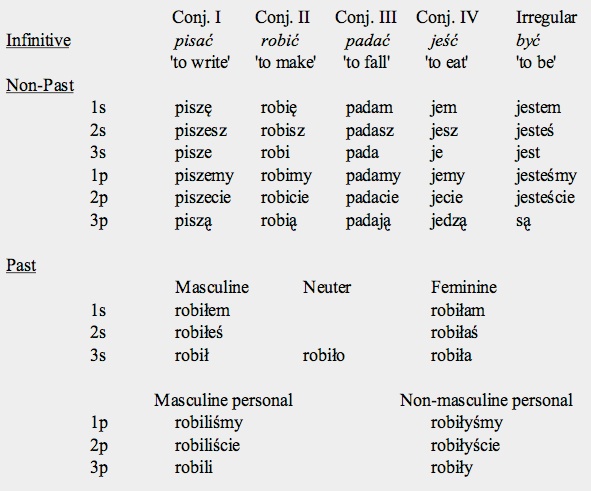
-
Non-past imperfective verbs (like those shown above) have present meaning but non-past perfective verbs have future meaning. The imperfective future is formed with the auxiliary będę (the future of być ), plus the imperfective infinitive or the l-participle:
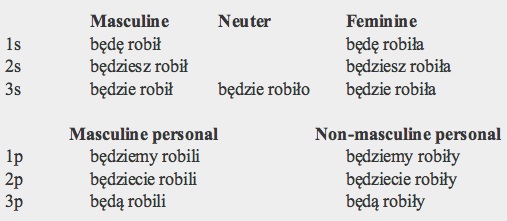
-
•mood: indicative, imperative, conditional.

-
The imperative has only 2nd person forms. The 2nd singular is obtained by dropping the last letter of the 3rd singular or 3rd plural of the non past; the imperative 2nd plural is made by adding the suffix -cie to the 2nd singular:
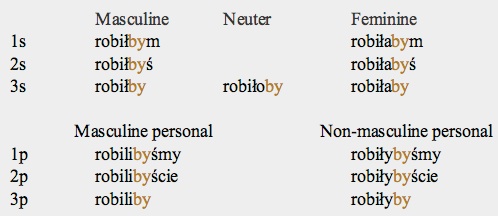
-
Polish has present and past conditional, the first meaning, 'I would do’, and the second 'I would have done'.
-
Nowadays, there is a tendency to use the present conditional for both meanings. The present conditional is formed with the past tense + the invariable particle by. The past conditional is formed by the present conditional of the verb być plus the l-participle. The conditional present of robić is shown above.
-
•aspect: imperfective, perfective.
-
The aspectual distinction between an incomplete (imperfective) and completed action (perfective) is a fundamental feature of the Slavic verb. Most unprefixed verbs are imperfective and perfective verbs derive from them by prefixation (e.g. robić → zrobić) or, less frequently, by suffixation or vowel change in the stem. However, there are also unprefixed perfectives.
-
•voice: active, passive, reflexive.
-
The enclitic reflexive pronoun się is employed to make reflexive constructions. Passive constructions are formed by combining the passive participle of transitive verbs with an auxiliary. The agent can be expressed with the preposition przez (‘by’) followed by the accusative case. To indicate a passive state the perfective participle is used with all three tenses of być (‘it was done, it is done, it will be done’).
-
•non-finite forms: infinitive, present verbal adverb, past verbal adverb, active participle, past participle, verbal noun.
-
‣Perfective and imperfective verbs have their own infinitive, all ending in -ć/c.
-
‣Imperfective verbs have a present verbal adverb, ending in -a̢c, that expresses an action simultaneous to the action of the main verb.
-
‣Perfective verbs form a past verbal adverb in -wszy or -łszy that expresses an action prior or subordinate to the action of the main verb.
-
‣Imperfective verbs have an active participle in -a̢cy that expresses an action simultaneous to the action of the main verb.
-
‣Perfective and imperfective verbs form past passive participles in -ny or -ty (equivalent to the English past participle).
-
‣Most verbs form a verbal noun in -nie оr -cie to name states or activities (‘singing, reading’, etc.).
Syntax
The basic word order in the sentence is Subject-Verb-Object but it is rather flexible. Verbs agree in person and number with their subjects, in the past tense they also agree with the gender of the subject. Adjectives agree in number, case and gender with the noun they modify. Subject pronouns are normally used only for emphasis and third-person subject pronouns are frequently dropped after their first use.
Within the noun phrase the relative order is: pronominal determiners followed by quantifiers, adjectives and head-noun:
-
te trzy piękne domy
-
these three beautiful houses
WH-questions are marked by the presence of an interrogative pronoun or adverb. Yes-no questions are marked by an initial czy or solely by intonation.
Lexicon
Early borrowings came from Latin, Czech and German. Later, Polish borrowed from Italian, French, Belorussian and Ukrainian. From the 19th century Russian and English are the major influences.
Basic Vocabulary
one: jeden (m)/jedna (f)/jedno (n)
two: dwaj (male person)/dwa (neuter and other masculines)/dwie (f)
three: trzej (male person)/trzy (non-male person)
four: cztery
five: pięć
six: sześć
seven: siedem
eight: osiem
nine: dziewięć
ten: dziesięć
hundred: sto
father: ojciec
mother: matka
brother: brat
sister: siostra
son: syn
daughter: córka
head: głowa
face: twarz
eye: oko
hand: ręka
foot: stopa
heart: serce
tongue: język
Key Literary Works (forthcoming)
-
© 2013 Alejandro Gutman and Beatriz Avanzati
Further Reading
-
-'Polish'. G. Stone. In The World's Major Languages, 289-304. B. Comrie (ed). Routledge (2009).
-
-'Polish'. E. A. Rothstein. In The Slavonic Languages, 686-758. B. Comrie & G. G. Corbett (eds). Routledge (1993).
-
-Polish Reference Grammar. M. Z. Brooks. De Gruyter Mouton (1975).
-
-The Polish Language. S. Westfal. Veritas Foundation Publication Centre (1985).
Polish

Address comments and questions to: gutman37@yahoo.com
MAIN LANGUAGE FAMILIES
LANGUAGE AREAS
Languages of Ethiopia & Eritrea
LANGUAGES by COUNTRY
LANGUAGE MAPS
-
• America
-
• Asia
-
Countries & Regions
-
-
Families
-
• Europe
-
• Oceania